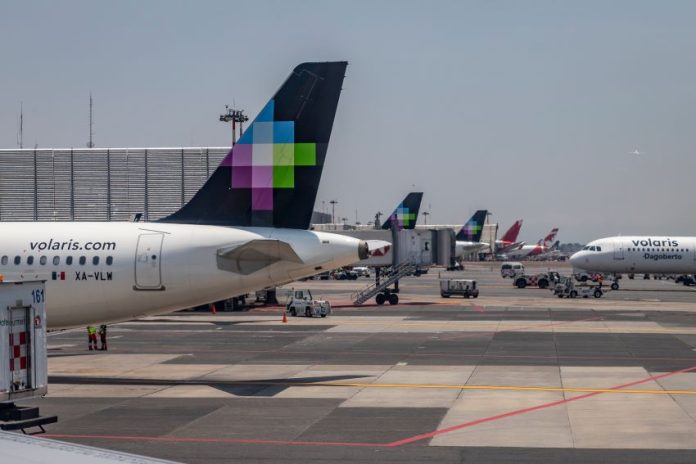The Mexico City International Airport (AICM) has announced that a range of airport fees will increase significantly in 2024, a move the National Chamber of Air Transport (Canaero) says will have a negative effective on Mexico’s competitiveness and raise the cost of airplane tickets.
The AICM and the Ministry of the Navy (SEMAR), which controls the airport, announced the fee hikes in a statement published on Monday.

What are the increases?
Fees payable by airlines for landing, the boarding and disembarkation of passengers, overnight stays for aircraft and the revision of passengers and their hand luggage are all going up by around 77%.
The fee increases apply to both domestic and international flights. The fees for the latter are significantly higher than those for the former.
The total amount payable by airlines for each flight varies depending on the weight of the aircraft they are operating, the number of passengers on board and the length of time their plane is remaining at the airport.
The airport use fee (TUA) for AICM will also increase on Jan. 1, 2024, but the hike is a much more modest 3.2%. The TUA will be US $28.95 for domestic passengers and $54.96 for international ones next year. The fee in pesos fluctuates depending on the prevailing USD:MXN exchange rate.
The argument for raising AICM fees
The AICM and SEMAR noted that the current airport service fees haven’t increased in over 13 years.
They also highlighted that the AICM fees are significantly lower than those at the 34 Mexican airports operated by the publicly-listed ASUR, GAP and OMA airport groups.

Even with the 77% increases, the new fees will continue to be lower than the ASUR/GAP/OMA average, the AICM and SEMAR said.
They said that the fee increases are among “the actions and measures” that the current AICM management is undertaking to make the airport more efficient and to strengthen its financial position.
The federal government declared in early 2022 that both AICM terminals had reached saturation point, and has been seeking to ease pressure on it by encouraging airlines to shift some of their operations to the army-built Felipe Ángeles International Airport (AIFA), which opened at a location just north of Mexico City last year.
Will airlines choose to make greater use of AIFA now that AICM fees are going up?
The aviation sector’s response to the AICM fee hike
Canaero outlined its opposition to the AICM/SEMAR announcement in a statement titled: “Excessive increase in AICM fees affects the country’s competitiveness and raises ticket prices.”

The 77% increase to the four airport service fees is not justified given the “high profitability” of the AICM, Canaero said.
Aviation sector companies and airline passengers will be adversely affected by the excessively high increases, the association said, adding that they will “take away competitiveness from the country’s main air connectivity center and all of Latin America.”
Canaero said that the AICM has “historically” generated sufficient income for the “optimal operation” of the airport, but much of that money is “diverted to purposes other than those of its operation.”
“… In 2022, the AICM generated almost 18.5 billion pesos [US $1.06 billion at the current exchange rate] and over 73% of [that amount] came from TUA passenger fees and airline airport service fees. The underlying problem is that [the airport’s] income isn’t wholly allocated to maintain and increase infrastructure,” the chamber said.
“… Canaero continues to acknowledge that the management of AICM by the Ministry of the Navy has been successful, orderly, neutral and transparent, but they’re working with very limited resources due to the diversion of … [airport] income,” it added.
The association issued an “urgent” appeal to financial authorities, saying that they should allow the AICM to use its own income to ensure that it is able to operate adequately.
“Canaero and its members are fully willing to … [contribute] with time and talent so that aviation in Mexico is competitive, accessible and continues to be a driver of economic development and social well-being. The solution mustn’t be making public services more expensive for the [Mexican] population and tourists,” it concluded.
The International Air Transport Association (IATA), the Latin American Air Transport Association and the National Tourism Business Council were also critical of the announced fee increases at the AICM.
“This decision will raise air fares for passengers, negatively affect airlines and jeopardize the country’s competitiveness,” the IATA said.
“Raising operating costs at Mexico’s main aviation hub is in stark contrast to the Mexican federal government decision to reduce fees and increase costs efficiencies at other airports in the country. Moreover, the Airport Usage Tax (TUA) at AICM is already one of the highest in the world,” it added.
“… IATA is asking that the increases be reconsidered, especially since the facilities at AICM have further deteriorated, thus not reflecting the high cost paid by airlines and passengers,” the Montreal-based association said.
“… AICM could operate in a profitable manner if its revenues were not used to fund other projects – such as the repayment of loans related to the canceled Texcoco Airport – but rather be reinvested into the maintenance, improvement and enhancements of its infrastructure and facilities.”
With reports from El Economista, El Financiero, El Universal and Reforma
